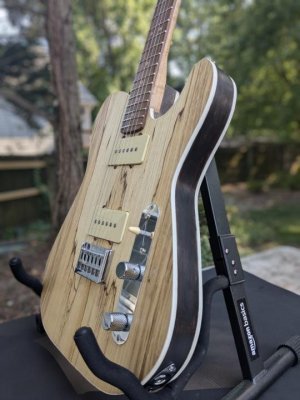mpatricklesley
New member
My current project is my take on a Thinline t-type. I'm planning to use a humbucker in the bridge and a single coil in the neck. I want to be able to split the humbucker to get some additional tonal versatility. I understand the wiring for that but I'm getting myself wrapped around the axle regarding polarity.
PLEASE correct me if I'm wrong, but here are my basic assumptions:
-To have to two single coil pups be in phase, one must be RWRP.
-In a SD humbucker, the south coil (red and green) is RWRP.
-An off the shelf SD single coil is not RWRP unless otherwise specified.
Ok, so operating off those three assumptions, if I split the coils in the middle position, and want and in phase sound, I need to send the north coil to ground, yeah? If I look at the SD wiring diagram for this (below), I'm pretty sure it shows grounding the south coil. IF I'm correct about that, the solution is just to switch wires - put the green on the blade and the black to ground on the pot?
Also, shouldn't the cases of the volume and tone pots be connected so the volume pot has a ground connection?
Wisdom would be appreciated.
https://www.seymourduncan.com/images/wiring-diagrams/Tele_1H_1S_3B_1VppSPL_1T.jpg
PLEASE correct me if I'm wrong, but here are my basic assumptions:
-To have to two single coil pups be in phase, one must be RWRP.
-In a SD humbucker, the south coil (red and green) is RWRP.
-An off the shelf SD single coil is not RWRP unless otherwise specified.
Ok, so operating off those three assumptions, if I split the coils in the middle position, and want and in phase sound, I need to send the north coil to ground, yeah? If I look at the SD wiring diagram for this (below), I'm pretty sure it shows grounding the south coil. IF I'm correct about that, the solution is just to switch wires - put the green on the blade and the black to ground on the pot?
Also, shouldn't the cases of the volume and tone pots be connected so the volume pot has a ground connection?
Wisdom would be appreciated.
https://www.seymourduncan.com/images/wiring-diagrams/Tele_1H_1S_3B_1VppSPL_1T.jpg

